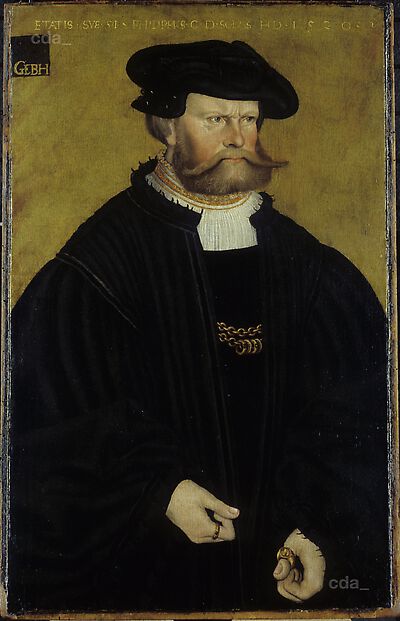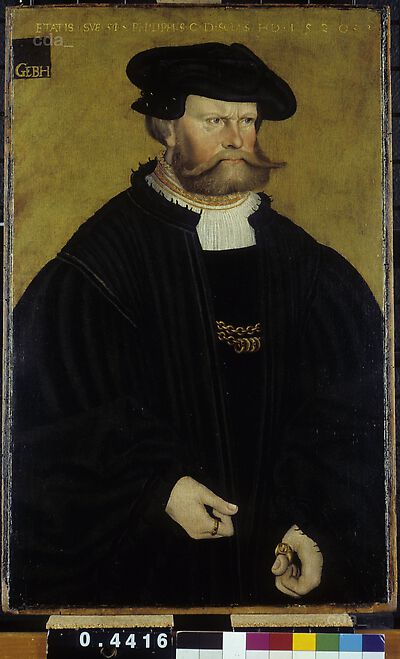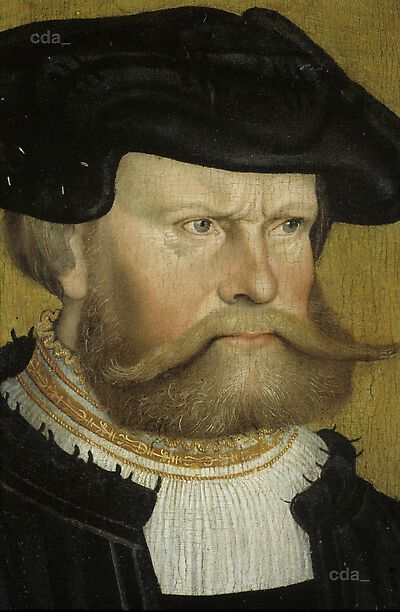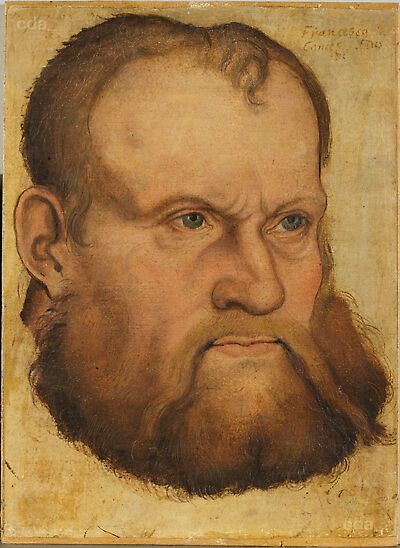Support
According to the owner limewood (Tilia sp.) was identified as the wood species used for the support (Dr. Klein, Hamburg). The panel consists of two vertically aligned boards (width: from the top left 21.3/18.8 cm; from the bottom left 20.5/19.6 cm). Both boards were painted on their left side (the opposite side to the heartwood). The joins were not reinforced with canvas or tow. Some small knots remain in the panel. The proportions and size of the support are similar to those of the standard format 'C' (h: 51 - 59 cm, w: 34 - 40 cm) employed by the Cranach workshop.
The reverse of the panel was smoothed with a block plane in the direction of the grain. The maximum width of the plane marks is c. 1.8 cm. The upper and lower edges exhibit a broad bevel, the side edges are straight. The panel is c. 0.8 cm thick here. It could not be established whether the dimensions were altered at a later stage. The wood was left exposed on the reverse.
Ground and Imprimatura
- the white ground contains calcium carbonate (chalk). The panel was fixed in a working frame when the ground was applied. The barbe along the edges is accompanied by an incised line that was executed with a relatively blunt instrument. The ground was applied in a number of layers.
Neither the x-radiograph nor the cross-sections show the presence of a pigmented isolating layer (imprimatura).
Underdrawing
The underdrawing was executed with a brush employing an fluid black medium. Above the right shoulder it is visible to the naked eye through the abraded paint layers of the background. Contours and details were carefully defined with particularly long brushstrokes. The ductus suggests that these lines reinforce a design, which had already been transferred to the ground layer. Close parallel hatching-strokes mark the areas of shadow on the cheeks, cheekbones and the bridge of the nose.
No corrections appear to have been made to the underdrawing. Deviations betweeen it and the final painted version are only visible in the moustache. This was initially positioned further down - similar to the portrait study in Bautzen. In comparison with the face the hat and the gown are strikingly free in their execution. The numerous broad and loosely drawn contours of the hat bear witness to the artist's search for a definitive shape.
The style of the underdrawing differs considerably from autographed works by Lucas Cranach the Elder. Even the contemporary workshop paintings examined differ from this painting in the execution of their composition. Superimposing the underdrawing from this painting on a tracing of the portrait study in Bautzen reveals that they are almost the same. The size and shape of the eyes as well as the space between the eyes and the mouth are identical. A smaller nose and shorter beard are the only deviations detected on this painting.
Paint Layers and Gilding
Flesh paint
The modulation of the face began with the application of an initial layer consisting of a pale admixture of lead white and very finely ground vermilion pigments. In this layer the shadows were created with the addition of black (vegetable black?) and brown pigments. A subsequent application of vermilion glazes reinforced the red colouring of the cheeks and nose, and succinct highlights accentuate the forehead and the wrinkles in the corners of the eyes. The x-radiograph records the pale base tone of the flesh paint and the rapid modelling of the face. The horizontal strokes highlighting the right eye were also employed on the portrait in Nieder-Weidbach.
Gown and jewellery
The black gown was executed employing an initial admixture of finely ground soot black and lead white. The brownish transparent inclusions visible in the cross-section fluoresce yellow in UV light, suggesting the presence of a natural resin. The addition of resin to the oil permited a softer modulation of the folds and reduces the drying time.
Beginning with a dark tone the paint was dabbed on and applied with brushstrokes in little more than two layers. Both layers are visible to the naked eye along the contours of the beret. Whereas the initial tone was applied before the green paint of the background, the second layer was executed over this green layer. Such alternating overlapping of paint layers suggests that by exploiting the drying times different areas of the picture were painted at the same time instead of progressing from one detail to the next.
Chains, rings and necklaces were initially blocked in with paint containing ochre (yellow ochre) (?) and vermilion (?), and followed by the pattern and highlights in lead-tin-yellow (with the characteristic inclusions). To represent semi-transparent precious stones red and green glazes were employed. The highlights here are white. The coat-of-arms that was initially blocked in with lead-tin-yellow and vermilion (?) originally had a green rather than brown border. Remnants of a green glaze can be identified under the stereomicroscope. The griffins were executed employing a blue pigment of unusually fine particle size.
Background
The background paint consists of varying ratios of green (verdigris?), pale yellow (lead-tin-yellow), dark yellow (ochre), white (lead white) and red (vermilion?) pigments. The pigment particle size is relatively large. Remnants of a reddish to brownish tinted semi-transparent layer suggest the presence of an original green or perhaps red glaze. Although the paint layer is badly damaged there can be no doubt that the reddish tone running diagonally across the background represents folds of cloth. The x-radiograph and the cross-sections show that these reddish forms were applied as part of the initial layer by adding more ochre yellow and vermilion pigments. They were rapidly executed with a broad brush.
Inscription, monogram and date
The inscription, the monogram and the date were all executed employing lead-tin-yellow. The age of the sitter has been corrected from '50' to '51' years. The '0' was covered with green paint, which is similar in composition to the remaining background paint. Accordingly the application and correction of the inscription concurs with the completion date of the painting.
Framing
The (most probably) original grooved frame has been preserved. The main flat profile and the molding along the sight edge (half-rounded batten and hollow) as well as the top molding were carved out of a single block of pine wood. The cornice was attached with wooden nails. At the corners the frame members were simply overlapped and fixed at the back. The joins are mitred at the front and partially mitred on the reverse. The frame exhibits a black (soot black) coating applied without a ground layer, and is decorated with ornamentation executed employing a reddish yellow mordant (lead white, red lead among others) that was subsequently gilded. The molding either side of the main flat profile was gilded with gold leaf.
[unpublished examination report, G. Heydenreich 1999]



